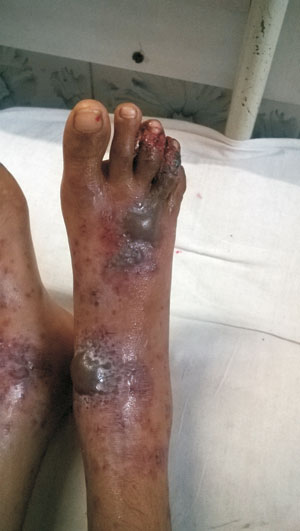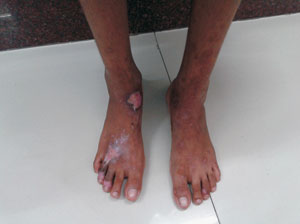A 12-year-old girl presented with digital ulcer, palpable
purpura and subcutaneous nodules involving the extremities (Fig.1).
Systemic examination was normal. Investigations showed a
raised erythrocyte sedimentation rate and C-reactive
protein. Liver function tests, renal function tests, and
complement levels were normal. Rheumatoid factor,
anti-nuclear antibody, anti-double stranded DNA, anti-neutrophil
cytoplasmic antibody, anti-phospholipid antibody, lupus
anti-coagulant and serum cryoglobulins were all negative.
ASO titers were normal. Mantoux test and serologies for
hepatitis B and C infections were negative. Deep incisional
skin biopsy from the foot lesion showed leucocytoclastic
small vessel vasculitis of the deep dermis. A diagnosis of
Cutaneous Polyarteritis Nodosa (CPAN) was made. The patient
responded to high dose pulse methyl prednisolone therapy and
is at present on low dose steroid for last 6 months without
any relapse (Fig. 2).
 |
 |
|
Fig. 1 The vesico-bullous skin lesions
with a digital ulcer.
|
Fig. 2 The healing lesions.
|
CPAN is a rare vasculitis affecting the
small and medium vessels of the dermis without any systemic
involvement of the liver, kidney or heart. CPAN should be
differentiated from systemic PAN which may present with
similar skin involvement but has florid systemic
manifestations. Unlike other vasculitis, CPAN lacks
immunological markers. It may be associated with
streptococcal sore throat, hepatitis B, C infection or
tuberculosis. Though affecting skin and having a good
prognosis, CPAN may be resistant to low dose steroids and
may require aggressive therapy with a relapsing course.

